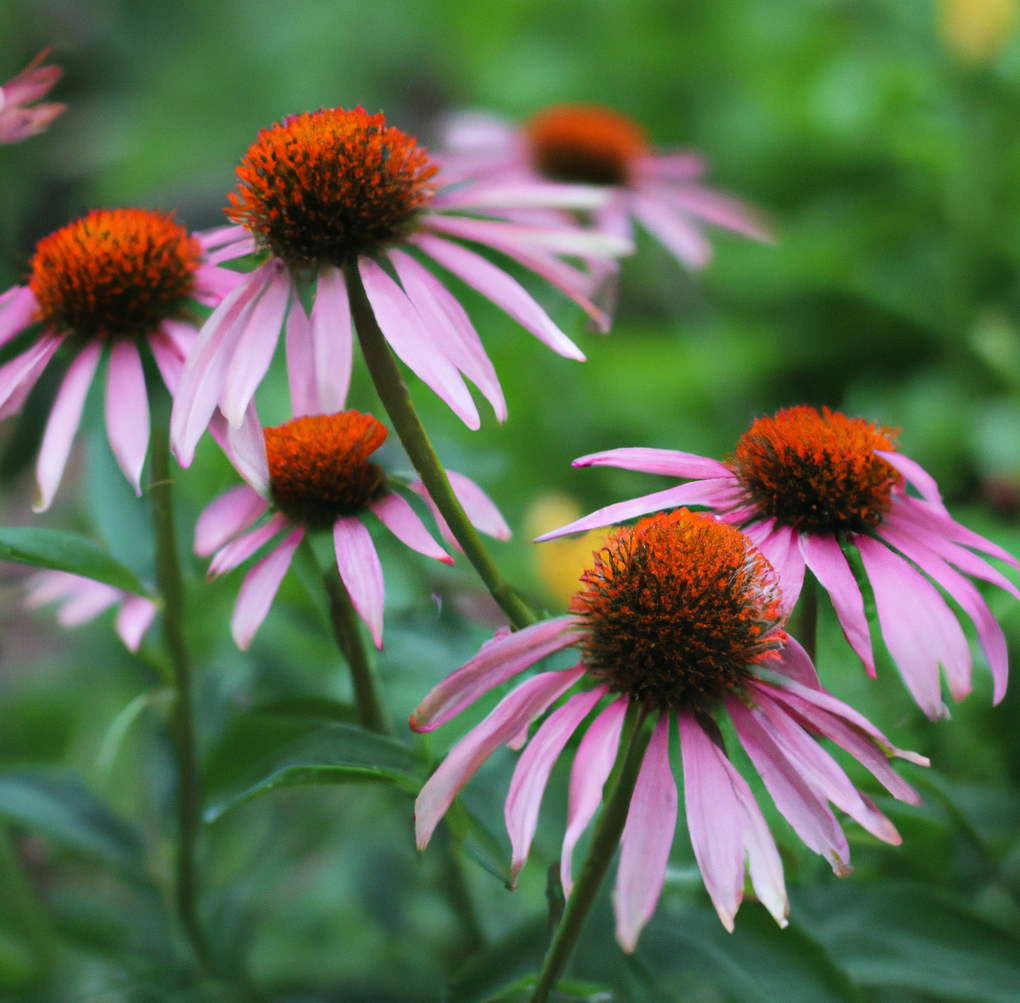Description
Flowers: Purple coneflowers produce large, daisy-like flowers that typically measure 3-4 inches (7-10 cm) across. The petals are lavender to purple, and they radiate outward from a prominent central cone. The cone is dark brown to orange and has a spiky, textured appearance. The flowers bloom from mid-summer to early fall.
Foliage: The leaves of the purple coneflower are lance-shaped, dark green, and have a rough texture. They grow in an alternate pattern along the sturdy, upright stems.
Height and habit: Purple coneflowers have a clumping growth habit and can grow to be 2-4 feet (60-120 cm) tall and 1.5-2 feet (45-60 cm) wide, depending on the variety and growing conditions.
Habitat: They are native to the eastern and central United States, where they grow naturally in prairies, meadows, and open woodlands.
Pollinator attraction: The flowers are highly attractive to pollinators such as bees, butterflies, and birds (particularly goldfinches, which feed on the seeds). This makes purple coneflowers a popular choice for pollinator-friendly gardens.
How to Grow Purple Coneflowers (Echinacea purpurea)
- Seed stratification (optional, but recommended): Coneflower seeds benefit from a period of cold stratification to improve germination rates. To stratify, mix the seeds with slightly moistened peat moss or sand in a plastic bag or container, and place it in the refrigerator for 30-60 days. Check periodically to ensure the medium remains moist, but not wet.
- Sowing seeds indoors: Around 6-8 weeks before the last expected frost date, start seeds indoors. Fill seed trays or small pots with a well-draining, sterile seed-starting mix. Moisten the mix and sow the seeds on the surface, lightly pressing them into the medium without covering them. Coneflower seeds need light to germinate. Maintain a temperature of 65-70°F (18-21°C) during germination.
- Germination: Place the seed trays or pots in a sunny location or under grow lights, ensuring that the seeds receive plenty of light. Keep the soil consistently moist but avoid overwatering. Germination should occur within 10-20 days.
- Seedling care: Once the seedlings have developed two sets of true leaves, you can transplant them into larger pots if needed. Continue providing ample light and maintain even moisture.
- Hardening off: Before transplanting the seedlings outdoors, acclimate them to the outside conditions by gradually exposing them to outdoor conditions over a week or so. Start with a few hours of shade and gradually increase the exposure to sunlight and outdoor temperatures.
- Transplanting outdoors: After the danger of frost has passed, transplant the seedlings into well-prepared garden soil. Choose a location with full sun to partial shade and well-draining soil. Space the plants about 18-24 inches (45-60 cm) apart.
- Care and maintenance: Water the plants regularly during the first growing season, but avoid overwatering. Once established, coneflowers are fairly drought-tolerant. You can also apply a balanced, slow-release fertilizer in the spring to promote healthy growth. Remove spent flowers to encourage more blooms and keep the plants looking tidy.
- Enjoy the flowers: Purple coneflowers typically bloom from mid-summer to early fall. Their vibrant flowers attract bees, butterflies, and other pollinators, making them a great addition to a pollinator-friendly garden.
FAQ for Purple Coneflowers (Echinacea purpurea) :
Q: What is the scientific name of the purple coneflower?
A: The scientific name for the purple coneflower is Echinacea purpurea.
Q: What type of growing conditions do purple coneflowers prefer?
A: Purple coneflowers prefer full sun to partial shade and well-draining soil.
Q: Are purple coneflowers perennial or annual plants?
A: Purple coneflowers are herbaceous perennials, meaning they come back year after year.
Q: When should I start purple coneflower seeds indoors?
A: Start purple coneflower seeds indoors 6-8 weeks before the last expected frost date in your area.
Q: How do I stratify purple coneflower seeds to improve germination?
A: To stratify purple coneflower seeds, mix them with moistened peat moss or sand in a plastic bag or container, and place it in the refrigerator for 30-60 days.
Q: How far apart should I space purple coneflowers when planting them in the garden?
A: Space purple coneflowers about 18-24 inches (45-60 cm) apart to ensure adequate airflow and room for growth.
Q: How tall do purple coneflowers typically grow?
A: Purple coneflowers typically grow to be 2-4 feet (60-120 cm) tall, depending on the variety and growing conditions.
Q: What types of pollinators are attracted to purple coneflowers?
A: Purple coneflowers attract a variety of pollinators, including bees, butterflies, and birds such as goldfinches.
Q: How do I care for purple coneflowers after they are established?
A: Water the plants regularly during the first growing season, then cut back on watering as they become more drought-tolerant. Apply a balanced, slow-release fertilizer in the spring, and remove spent flowers to encourage more blooms.






Reviews
There are no reviews yet.